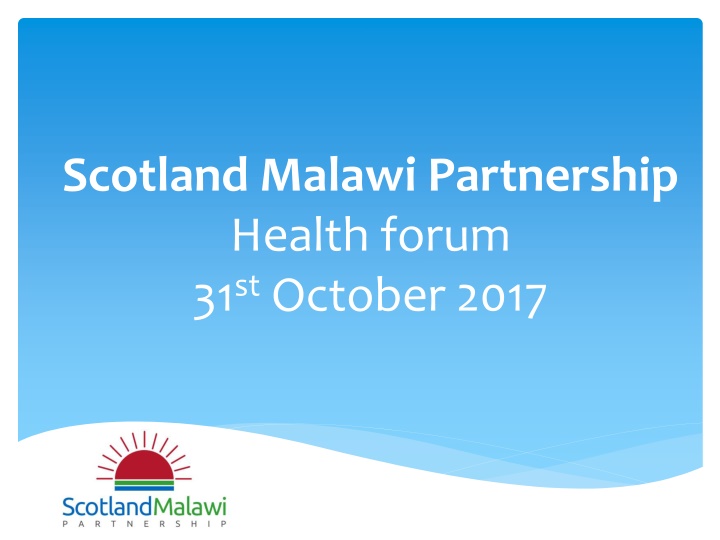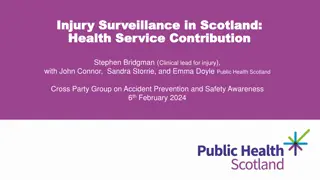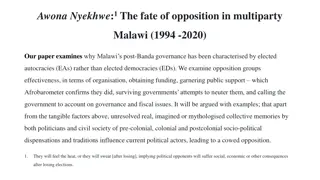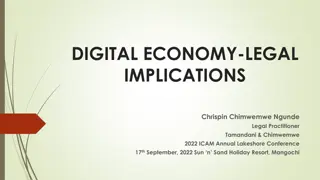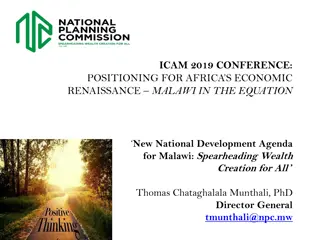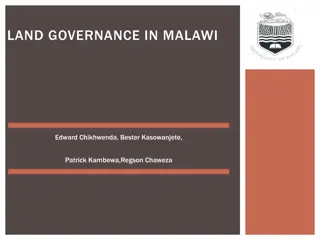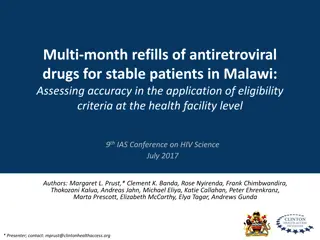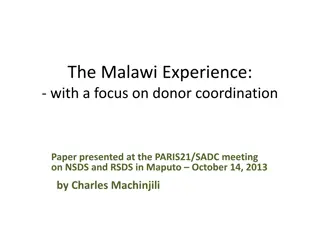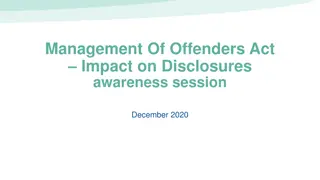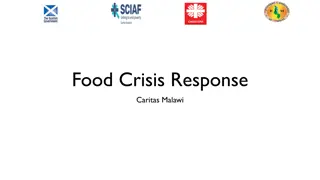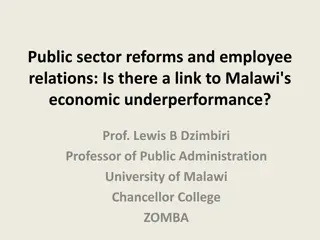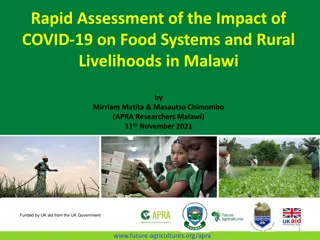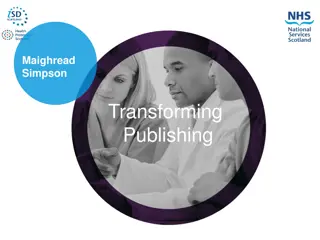Scotland Malawi Partnership Health Forum
Malawi health sector challenges, priorities, governance issues, key players, and solar power benefits discussed at the Scotland Malawi Partnership Health Forum in 2017. Interviews with key Malawian health figures, insights on young people's challenges, barriers to equal access, and solutions in the sector are highlighted.
Download Presentation

Please find below an Image/Link to download the presentation.
The content on the website is provided AS IS for your information and personal use only. It may not be sold, licensed, or shared on other websites without obtaining consent from the author.If you encounter any issues during the download, it is possible that the publisher has removed the file from their server.
You are allowed to download the files provided on this website for personal or commercial use, subject to the condition that they are used lawfully. All files are the property of their respective owners.
The content on the website is provided AS IS for your information and personal use only. It may not be sold, licensed, or shared on other websites without obtaining consent from the author.
E N D
Presentation Transcript
Scotland Malawi Partnership Health forum 31st October 2017
Malawian input videos Interviews with: Emma Mabvumbe, Director of Planning and Policy Development Ministry of Health Dr. David Morton, Deputy Medical Director Nkhoma Hospital (Partner with CofS) George Jobe, Executive Director Malawi Health Equity Network Dingaan Mithi, Programme Manager JONAIDS Beatrice Kabota, Cervical Cancer Screening Coordinator Nkhoma Hospital And a health service user called Victoria They were asked: 1. What are the key challenges in the Malawi health sector? 2. What are the key priorities for the Malawi health sector? 3. What are the key governance issues in the Malawi health sector? 4. What are the key structures or systems in the Malawi health sector? 5. Who are the key playerswithin Malawi s health sector? 6. What are the Do s and Don ts for developing health projects?
Questions for Malawi Panel Question: Would solar power help health clinics and hospitals? Answers: Malawi has health facilities that do not have electricity in rural areas. This affects service delivery especially in maternity wings where midwives use candles or torches on their mobile phones. The situation is also experiences in urban as currently Malawi is facing a lot of power outages/blackouts. Solar is the best answer. More is it green energy. Use of solar in rural areas is also a motivation to health workers to work in rural areas including hard to reach locations.
Questions for Malawi Panel Question: How are young people affected by the different challenges in the sector? Answers: Young people are affected in the health sector in many ways. Firstly, access to reproductive health services is a challenge due to the stigma attached to accessing the same. Thus, if a 15 year old has an STI for example, she will be afraid to go to a government clinic though free to access treatment. That disease will therefore go untreated thereby posing health challenges for her in the future. For private clinics services are inaccessible to young people due to costs.
Questions for Malawi Panel Question: What are the key barriers to equal access? Price? Distance to service delivery? Answers: Government facilities are free but the challenge is availability of drugs and other equipment due to less funding. Distance is another issue, example, cervical cancer screening in most districts is only at the district hospital so those living very far away can t access it. Shortage of health providers is another challenge. Most facilities they have less burse or clinician as required. Some people walk long distances to health facilities, which is beyond the Malawi Government benchmark of 8km radius. This is a result of having fewer health facilities than needed, although the Government entered into Service Level Agreements with facilities owned by Christian Health Association of Malawi. Inadequate health workers, which is highly manifested in rural areas. Drug stockouts are also a barrier.
Questions for Malawi Panel Question: Where does cancer sit in Malawian priorities? A major part of NCD or a separate strategic objective? Answers: Cancer is an important priority in Malawi s new health sector strategic plan. Is it also a top priority in the pipeline work to review the national NCD action plan for Malawi. That is why the national cancer centre is being built to improve quality of care. Cancer is one of the major conditions affection Malawians. And is it one of the priority areas. For instance, there have been many campaigns against cervical cancer. Even the First Lady of Malawi has been mobilising ladies undergo screening of cervical cancer. In recent years there have been a number of cases of the other cancers such as prostate in men. No wonder construction of a Lilongwe Cancer Centre was started. Many people will be saved. Malawi will also save money as some patients have been seeking treatment abroad in such countries as India, South Africa and Tanzania.
Questions for Malawi Panel Question: Where does cancer sit in Malawian priorities? A major part of NCD or a separate strategic objective? Answers: Cancer is a major part of the NCD agenda, it is not a separate objective. It mainly falls under Objective 1 of the HSSP II as part of the Essential Health Package (EHP). Screening for cervical cancer is the intervention included in the EHP and meant to be rolled out nationwide. The Ministry of Health is currently constructing a Cancer Treatment Centre at the Kamuzu Central Hospital in Lilongwe due for completion in September 2018. The Ministry of Health also successfully piloted the Human Papiloma Virus (HPV) vaccine in two districts (Rumphi and Zomba) and it will be rolled out nationally.
Questions for Malawi Panel Question: What are the barriers to digital technology adoption in health services delivery? Answers: Barriers to digital technology adoption include inadequate funding, high disease burden, high purchasing prices, weak supply chain management, lack of drug storage spaces, unreliable information systems, irrational use of medication, leakage and pilferage.
Questions for Malawi Panel Question: What have we done that has had a positive/negative impact in the health system in Malawi? Answers: Cervical cancer screening project at Nkhoma has a positive impact in Malawi as it has given alternative treatment in Malawi and other African countries too. This kind of project to be rolled out into other parts of Malawi. Malawi has reduced maternal and national mortality rates because of deliberate efforts to have a number of programmes e.g. Safe Motherhood, outreach clinics, community nurses and ensuring that Health Surveillance Assistants handle multiple issues at grassroots/community level. Increasing programmes in HIV/AIDS has helped to reduce and contain national HIV prevalence rate from 14% to around 9%. Cholera cases were not registered in the last rainy season because of a number of awareness raising campaigns, issuing of certificates to chiefs whose areas observed open defecation free status. There is also collaboration by MoH with other stakeholders such as the Water Department, the private sector and civil society organisations. One of the major areas we have not done to hire all health workers who have been trained by out colleagues although the same human resources are highly needed in our health facilities. Malawi is also falling short of meeting the Abuja Declaration, which states that at least 15% of the national budget should go to health sector. We once met the target in 2014 only.
Questions for Malawi Panel Question: One of the themes in the videos is lack of resources what do you think is the solution? Answers: According to the latest resource mapping exercise the GOM and some donors have committed allocations of approx US607 million to the health sector in 2016/2017 financial year. 565million for 2017/2018 432million for 2018/2019 423million for 2019/2020 Based on these estimates we have a funding gap of 89million for 2018/2019 and 117million for 2021/22. The gaps can be filled by relocating resources from other sectors among other sectors among other things as well as negotiations with donors on possibilities of increasing their commitments. Other issues to be done will be to strengthen systems in the health sector to reduce corruption.
Questions for Malawi Panel Question: How can Malawi support better funding for health services? Answers: The government has to make health a priority, only 25% of the health cost are met by the government.
Questions for Malawi Panel Question: What challenges are you facing with cancer screening? Answers: In our opinion as Malawi Health Equity Network, some of the challenges are: some misconceptions that cancer can be suffered by those HIV positive, and long distances to health facilities especially in rural areas, and the inadequate numbers of health workers.
Questions for Malawi Panel Question: I am interested in views about the leadership and management in the health sector. Answers: Health sector strategic 2017 to 2022 plan is an excellent document then just need to implement it. The question is, do we have the resources?
Questions for Malawi Panel Question: I am interested in views about the leadership and management in the health sector. Answers: Leadership and management of the health sector is at different levels. District Health Management Teams (DHMTs) are in charge of the whole district health care system. The District Health Officer is the head of the DHMT. Districts comprise the primary and secondary health care system. DHOs report to District Commissioners who are accountable to the legislature. DHOs receive technical backstopping from Zonal Health Support Offices (ZHSOs) that are an extension of the Ministry of Health headquarters. Central hospitals (tertiary level) are managed by Hospital Management teams headed by a Hospital Director. At the central level, the Secretary for Health leads a Senior Management Team (SMT) that comprises Directors of Departments at the National Level and Central Hospital Directors. This is the policy formulation and oversight body of the whole health sector. The Senior Management Team of the Ministry of Health interfaces with a Health Donor Group, a committee of major health sector donors that supports the SMT in oversight of the sector. There are thematic technical working groups (TWGs) at the national level that provide a governance function of the sector and deliberate key health care delivery issues and report to the SMT. They draw membership from Government and other health stakeholders. Leadership and management capacity at all levels and in TWGs depends on the availability of appropriately qualified individuals.
Questions for Malawi Panel Question: What would be the best way to involve and include young people? Answers: As MaSP will make use of the school partnership programme to actively engage young people in a meaningful manner. We will engage with youth led organisations including those which are funded by the SG and those which are not. We will make use of organisations like Jubilee Enterprise and Social Enterprise Academy to get a wider reach. We will use open days for schools where MaSP will have a desk and share health related information with young people give them an opportunity to express themselves.
Questions for Malawi Panel Question: How can Malawi ensure a sustainable drug and equipment supply for services? Answers: Actively engage private sector organisation. Identify loop holes in the supply chain. Strengthen procurement systems we have had instances in which equipment is procured but there are not rained personnel to use it or we have equipment but we do not have space it, or we have equipment but without materials to use it. The Government needs to put more funds in health sector but other stakeholders too can come in to close the gaps. Include health in some of the national levies.
Questions for Malawi Panel Question: How can a project best support the wellbeing of staff? Answers: A project needs to consider constructions of additional houses for health workers at all levels. Hardship allowance for those operating in hard-to-reach areas. Support with some required equipment as well as supplies, ensure there are reliable sources of energy e.g. solar for their homes and the health facilities they work in, and ins-ervice refresher courses.
Questions for Malawi Panel Question: What are the current health prevention campaigns for cancer prevention? Answers: Cervical cancer is one of the greatest concerns and its preventable. They are planning to roll out into all ART clinics as HIV pose a great risk to cervical cancer. And there are also planning national scale up of HPV vaccination in 2019.
Questions for Malawi Panel Question: I am interested in how the new HSSP will support the Malawian health workforce. Answers: Although some progress was made under the HSSP 2011/2016 in training, recruiting and retaining HR for the health sector the country still faces critical shortages of key health technical cadres. The HSSP 2 therefore will attempt to address this by creating more posts in the critical cadres, and improve the distribution and strengthen the motivation of health workers where motivation shall indeed increasing salaries as one of the strategies. A functional review of the ministry of health will also be conducted to rationalise the HRH across levels of care in light of devolution of payroll to DHOs.
Questions for Malawi Panel Question: What are the health and social problems of albinos. Is it changing for the better or worse? Answers: Access to sunscreen lotion especially for people with albinism from poor families and rural areas. Stigma associated with people with albinism. It used to be rumoured that they do not die but just go missing, now the nation knows that they are killed for their bones as they are used for rituals. They are living in fear and though there was a presidential decree to police to provide protection the enactment and implementation of that decree is yet to be outlines as they are spread across communities. The society for people with albinism is doing a registration for all members at the moment.
Questions for Malawi Panel Question: What are the plans to improve funding for nursing staff within government facilities? Answers: Nursing staff do not receive specific funding. Funding goes to institutions i.e. hospitals. The MoH is exploring various health care financing reforms including the potential establishment of a health fund to supplement the national health budget and establishment of a national social health care scheme.
Questions for Malawi Panel Question: What are the Malawian MoH doing to improve equity of health access? Answers: Our observation as Malawi Health Equity Network, although we are still advocating for equity in health, is that: The theme of the Health Sector Strategic Plan II is Universal Health Coverage There is a policy that nurses who are undergoing training should be ready to work in rural areas. It seems that Government has now serious to ensure every district has a district hospital E.G. Palibe Districts Health Hostpital MoH now has a Quality Directorate which is also responsible with social accountability
Questions for Malawi Panel Question: HSSPII has >60% vacancy rate for clinical offices and nursing officers and NMT. How does the Malawian Government aim to address this area in terms of senior/well-qualified staff? Answers: MoH allocates resources for pre-service training every fiscal year to train health workers across various priority cadres. In addition, Government with its own resources and resources from other Donors like the Global Fund and Centres for Disease Control (CDC) are recruiting health workers for public health facilities.
Questions for Malawi Panel Question: In the video interviews, Victoria says that regular electricity in health centres and hospitals is the biggest challenge. Is this addressed as part of HSSPII? Answers: Yes. There is a capital investment plan, an ancillary document of the HSSP II that details infrastructure, medical equipment and utility needs of health facilities in Malawi. In addition, the Ministry is currently installing solar electricity in some facilities.
Scotland Malawi Partnership Health forum 31st October 2017
